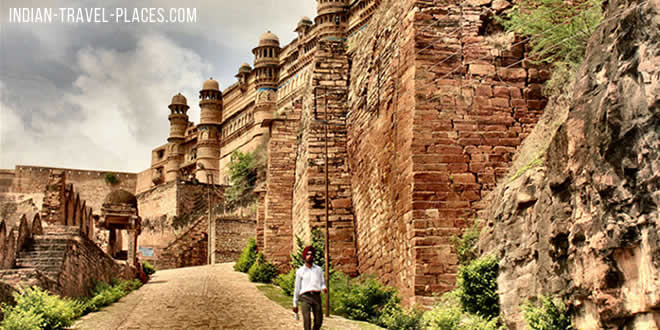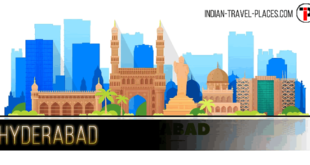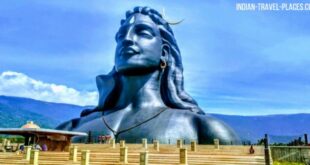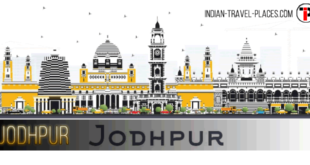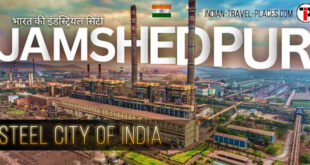Gwalior is a city in the central Indian state of Madhya Pradesh. It’s known for its palaces and temples, including the Sas Bahu Ka Mandir intricately carved Hindu temple. Ancient Gwalior Fort occupies a sandstone plateau overlooking the city and is accessed via a winding road lined with sacred Jain statues. Within the fort’s high walls is the 15th-century Gujari Mahal Palace, now an archaeological museum.
| Name: | Gwalior – City of Music |
| Location: | Gwalior District, Madhya Pradesh, India |
| Climate: | Summers: 48° C (Max), 24° C (Min) | Winters: 36° C (Max), 9° C (Min) |
| Best Time To Visit: | October to March |
| Nearest Airport: | Gwalior Airport |
| Railway Station: | Gwalior Railway Station |
| Must Visits: | Gwalior Fort, Tansen Tomb, Gujari Mahal and Jauhar Kund |
| Language Spoken: | Hindi and English |
| STD Code: | 0751 |
Gwalior is a historic city in the Indian state of Madhya Pradesh. It is located just 423 km away in north from the state capital, Bhopal. It comes under the administrative district of Gwalior. This city is spread over an area of about 289 square kilometers and is one of the historically significant cities of India. Gwalior is world renowned for its outstanding palaces, sacred temples and glorious monuments. Gwalior is located at an average elevation of 196 m above the sea level. Similar to the other cities of central India, Gwalior also features a subtropical climate with extremely hot summers (Late March-Early July), cool dry winters (Early November-Late February) and humid monsoons (late June- early October). Keeping extreme weather conditions in view, October to March is the best time to visit this evident city of glorious history.
History of Gwalior says that it owes its name to a sage of ancient times. The legend goes thus – Suraj Sen who was a prince of the Kachhwaha clan during the 8th century had lost his way in the jungle and ultimately strolled up to an isolated hill. Thereafter, he met an old man, Sage Gwalipa, whose influence almost took him by surprise. On asking the sage for some drinking water, he was led to a pond. The pool water not only doused his thirst, but cured him of leprosy as well. Out of gratefulness he wished to offer something in return to the sage and the sage asked him to build a fort on the hill. Thus, came up the fort named Gwalior, and ultimately the city that developed around it got its name. Gwalior Fort was ruled by several empires including the Tomaras (8th Century), Mughals, Maratha Scindia’s (1754), Rani of Jhansi Lakshmi Bai, Tatya Tope and the British.
Gwalior Fort is an emblem of rich architecture, and is often honored as the ‘Gibraltar of India’. Even great Emperor Babur described it as “the pearl in the necklace of the forts of Hind.” Rich in cultural heritage and architectural marvels, Gwalior has the added advantage to Indian tourism industry which attracts thousands of tourists and visitors every year. Gwalior has it all – a vibrant past, towering palaces, ancient temples and beautiful mosques. Some of the places where one can experience the history and rich heritage of India are Gwalior Fort, Tansen Tomb, Gujari Mahal and Jauhar Kund Tomb of Rani Lakshmibai, Maharaj Bada, and Gargaj ke Hanuman (गरगज के हनुमान) (temple). For those who love shopping, you can get ethnic handicrafts and stone artifacts from the Jayaji Chowk. This land of sword fights, rock carved temples and convoluted palaces make up the ingredients for a perfect holiday destination.
Best Time To Visit Gwalior
Gwalior, the glorious city of Madhya Pradesh, entices tourists with its iconic monuments, stunning edifices and famous educational institutes. A trip to this tourist capital of Madhya Pradesh is incomplete without a stopover at the famous Gwalior Fort and the magnificent Jai Vilas Palace. Gwalior is also known for its mouth-watering royal cuisine and of course, its friendly local inhabitants. The exotic fish dishes and delicious kebabs carrying regal flavors and scrumptious taste are tongue tingling. Every nook and corner of Gwalior has something interesting in store and it’s up to the visitors to discover it. The tourist capital of Madhya Pradesh is rich with tourism spots and if you patiently unravel the shopping streets, layer by layer, you will walk back home with bundle of great souvenirs. Extremities characterize the climate in Gwalior, which means summers are hot and winters are icy cold. However, tourists keep pouring in huge numbers despite of the intense weather conditions of the place. To know more about the ideal time to visit Gwalior, scroll down the article further.
Ideal Time To Visit Gwalior
Summer:
Summer in Gwalior lasts from March to May and is definitely not an apt time to visit, unless you love walking around the streets under the flaming sun. Being extremely humid, it’s an unpleasant experience to explore the place in sweltering heat. To cool off the body and beat the rising temperatures, people can be seen gulping down glasses of fruit juices and eating scoops of ice creams during summer. In case you happen to be in Gwalior during this time, make sure you wear something light and comfortable.
Monsoon:
The monsoon in Gwalior is characterized by moderate rainfall and lasts from June to September. The average rainfall is recorded at 700 mm. The restaurants and the local eateries serving yummy stuffs like kachoris, spicy potato dumplings, Morena Gazak, samosas in evening can come to your recue and aid in keeping your body warm. Sometimes, excess rainfalls lead to muddy lanes and water logged roads that may irk you if you are out.
Winter:
Just like the extremely hot summers, even the winters are too frigid here. While the maximum temperature during the winters is 210C, the minimum temperature can go down as low as 40C. November marks the onset of winter season, which lasts until February. The winters here are more preferable than the scorching summer heat. So, do dump in a lot of sweaters, woolen caps and jackets in your travel bags, as the weather can get nippy especially at night when the temperature drops down considerably.
Opting For Your Favourite Season:
The right time to visit Gwalior is from October-March since the weather is balanced. Most of the travelers hit this tourism spot during this period, as the climate is neither too hot nor cold. Gwalior is a land of fairs and festivals and each month there are vibrant cultural fests or religious events happening. Some of the festivals that are celebrated with great vigor and pomp are Tansen music festival, Bhavbhuti Samaroh, Ramleela festival, Gwalior international trade fair, Diwali, Vishwakarma Puja among others. While in November, Tansen music festival is held, the much-awaited Baba Hira Bhumia’s fair is conducted in August or September. The people of Gwalior are adjusting and friendly in nature. So, don’t hesitate to ask for directions if you are stuck up in wrong places and need some instructions.
History of Gwalior
The historical city of Gwalior unveils a legacy that remains unparalleled in the pages of history. Home to architectural marvels like Scindia Museum, Gujari Mahal and Gwalior Fort, everything about Gwalior is steeped in history. The city of Gwalior has stood strongly against the vicissitudes of power play and has served as the seat of power and wealth at one time. Being the land of Tomars and Scindias, much of the history of this place is dominated by the chronicles of the regal dynasties. Admired for its outstanding temples, beautiful palaces and glorious past, the city is truly a treasure trove of regal splendor. The massive Gwalior fort, which is popularly described as the ‘pearl in the necklace of the castles of Hind’, elaborates the grandeur of the city. To know more about this city, take a look at the history of Gwalior. The article below will help you unearth the historical events that left an indelible impression on the heart of the city.
Gwalior History
Origin Of The City:
According to a legend, a prince named Suraj Sen of Kachhwaha clan lost his way while hunting in the forest. Wandering through the forest, he reached a hill where he met an old sage called Gwalipa. Worn-out and hungry, the prince asked for some water to drink. The sage took him to a nearby pond and on drinking the water of the pond, the deadly leprosy disease from which Suraj Sen was suffering was completely cured. Overjoyed, Suraj Sen desired to give something to the sage in return as a token of appreciation. The sage accepted his offer and asked him to fortify the hill in order to protect other sages from the wild animals. Subsequently, Suraj Sen established a fort that was named Gwalior in the memory of sage Gwalipa. Thus, form this glorious fort the city got its name of Gwalior.
Ancient History:
The legendary history of Gwalior relates the saga of royal past, spectacular monuments and glorious relics. The cave paintings and artifacts belonging to Iron and Stone Age portray the ancient connection to the oldest civilization of the land. This princely city has served as home to dynasties like Kachhwaha Rajputs, Tughlaq dynasty, Slave dynasty, Tomar dynasty, the Mughals and even British. The first noted dynasty of the city, the Kachhwaha Rajputs, remained in power for many decades. Finally, in 1394, the Tomar dynasty established its rule. However, due to continuous clashes with neighboring states, the Tomars lost their land to Moghuls. Over the next few decades, the city was ruled by several other dynasties including the Scindias and British.
1857 Revolt:
The 1857 revolt of Gwalior acted as the first bloodiest war against British in India. To escape from the hands of British, Rani Lakshmi Bai, the legendary queen of Jhansi, sought shelter at Gwalior fort. Not willing to lose his fort, Maharaja Jayajirao remained loyal to British but his soldiers rebelled against British in respect for Rani and fought boldly against the British army. During this dramatic event, the supreme force of British killed Lakshmi Bai and the rebel leader Tatya Tope was hanged and Rao Sahib escaped. After this episode, the Gwalior fort and the city was captured by the British.
Spectacular Growth After Independence:
After independence, Gwalior along with major cities like Indore, Malwa and other small provinces formed a new state called Madhya Bharat. The present day Madhya Pradesh was formed by conciliating Madhya Bharat, Bhopal, Vindhya and Maha Kosal. Today, the fort city Gwalior is known for its business expertise. The cloth mills and industries of the terrain are admired for their fine work. Apart from the industrial growth, the city has made spectacular progress in educational background by housing some of the prestigious institutes in the country.
How To Reach
Known for its strong heritage, royal magnificence, and not to forget, it’s massive medieval hilltop fort, the city of Gwalior is quite famous in the pages of history for its royal lineage. The timeless appeal of this historical city is unparalleled. On your visit to this city, you can experience the lost glory of the bygone medieval era. Flecked with innumerable breathtaking architectural delights, Gwalior is a rich repository of many historical monuments that shows off the regal grandeur of the place. With the brilliance of its imposing fort and influence of classical music reeking through every lanes of Gwalior, a trip to this land would leave you mesmerized. Situated close to Gwalior are major tourist destinations like Agra, Jaipur and Khajuraho that shores up tourism of Gwalior. The well-connected road, rail and airways to the city further increase the number of visitors by creating comfortable journey. Before planning to explore the grandeur of this land go through the writing below which provides all the necessary information on how to reach Gwalior.
Traveling To Gwalior
By Air:
Gwalior airport, located at a distance of 8 km from the main city, is well connected to all the major cities of India. Well equipped with all the modern amenities, the airport of Gwalior is believed to be one of the finest in Madhya Pradesh. Many flights operating back and forth from the town provide regular service to some of the noted cities like Delhi, Agra, Mumbai, Varanasi, Bhopal, Jaipur and Indore. Some of the major airlines operating from Gwalior are Indian Airlines, Air Deccan, Kingfisher, Jet Airways, Air Sahara and SpiceJet. From airport, you can continue towards Gwalior by using private taxi or public transportation. For international destination, the city depends on Delhi airport, which is situated at a distance of 321 km.
By Rail:
Travelling to Gwalior by train is one of the most convenient options. The Gwalior railway station, located within the city, acts as one of the major railway station of country, which connects the city to most of the other renowned cities. Situated in Delhi-Mumbai and Delhi-Chennai route, Gwalior junction serves as one of the main stops for most passing trains. Some of the major cities linked by this rail route are Amritsar, Ahmedabad, Bangalore, Chandigarh, Chennai, Dehradun, Delhi, Mumbai, Hyderabad, Patna, Kolkata etc.. Apart from the major railway station, there are several small junctions like Gwalior Sithouli, Gwalior Birla Nagar, Gwalior Grasim Factory and Motijheel, which help you to reach to the nearest destinations. The noted trains passing through Gwalior are Goa Express, Chambal Express, Punjab Mail, Shatabdi Express, Grand Trunk Express etc. From the railway station, you can reach your destination by using pre-paid auto rickshaws and private taxis.
By Road:
Good network of roads and better bus facilities makes the journey to Gwalior cozy and comfortable. The national highways like NH3 and NH 75, which passes through the city, takes you to other cities located close to Gwalior. Provided with number of sate owned and private buses, the place connects to major cities like Agra, Delhi, Jaipur, Lucknow, Indore, Ujjain etc. Among the available bus service, you can chose from the AC, non-AC, deluxe and super deluxe buses based on your comfort and convenience. Being the major tourist destination in Madhya Pradesh, the tourist buses almost always remain chock-full with eager tourists. Thus, booking your tickets in advance is recommended. To explore the beauty of the city you can opt for city buses, auto rickshaws and taxis that are easily available.
Places To Visit
Gwalior, the princely city of Madhya Pradesh, evokes grandeur and royalty in indisputable style. The regal forts, palaces and not to forget, the oldest bazaars lives up to their reputation and impresses the visitors with their graceful beauty. October to March is the ideal time to visit this place. If you are lucky enough to be at this place in the month of November or December, then don’t miss to catch up on the biggest and the most celebrated Tansen music festival that happens every year at Tansen Memorial. To take home some lovely memorabilia, hit the iconic Patankar bazaar or the Government emporiums that offer some best deals. Someone had rightly said that when in Gwalior, there is never a place for boredom, for there is so much to see, feel and do. Being culturally deep-rooted, the people here have a huge respect towards folk music and other ethnic festivals. Discover more about the famous tourist attractions in Gwalior by scrolling down the article further.
Tourist Attractions
Gwalior Fort:
Gwalior fort that has a rich trail of legacy behind it is elegantly built and is majestic in its appearance. The ancient fort, sprawling across 3 km and 35 m in height, is easily one of the most important landmarks in the city. It is hard to miss out this important tourist spot that catches your attention. Within this magnificent building, there are other important tourism attractions like the Karan Palace, the Jehangir Mahal, the Shah Jahan Mahal and the Gujri Mahal. Also, check out the water tanks and three temples housed inside the fort premises.
Jai Vilas Palace And Museum:
The pearly-white Jai Vilas Palace is currently the residence of the royal Scindia family. The structure and the well-lit rooms inside the palace gives enough glimpse about the royal lifestyle led by yesteryear’s kings and queens. The bright Darbar Hall, comprising of two central chandeliers, is not just eye-catching but also serves as the main highlight of the palace. Every detail you find inside this building, be it draperies, ceilings, fine Persian carpets, tapestries, antique furniture, gives you a glimpse into the regal heritage.
State Archaeological Museum:
To get a slice of the historical condition of Gwalior and to see its rare antiquities, try visiting this famed archaeological museum. Located right opposite to the Hathi Pole gate of the Gwalior Fort, the museum houses a splendid collection. Copper plates, sculptures, inscribed seals, stone pillars, inscriptions, stone capitals, metal images, sati stones, terracotta, paintings and rare coins can all be sighted here. You can hire taxi, auto rickshaws or mini buses from Gwalior to reach this place.
Tigra Dam:
Tigra dam is the best place to go if you are looking for some real fun and leisure. Located on the banks of Chambal River, Tigra dam is a picturesque place and a hot favorite among nature admirers. People, besides, chilling out around the lake, can be also seen indulging in fishing. Situated exactly 23 km away from Gwalior, this place is crowded with tourists especially during weekends and public holidays. Tigra dam is a solace for the stressed-out souls and for those who want to escape the unbearable heat during the summer months.
Gwalior Zoo:
If you are bored of visiting the same old monuments and palaces, then Gwalior zoo may just come to your rescue. Get adventurous and gear up to explore the rich flora and fauna of this zoo. Have face-to-face interaction with some wild species including tigers, elephants, chimpanzees, bears, deer, etc that are housed within premises of the zoo. Children can have gala time by taking part in fun rides apart from exploring the wild species.
Shopping In Gwalior
The first thing your loved ones will ask once you reach back home after a vacation or a week of holidaying is for the exquisite souvenirs. It wouldn’t be an exaggeration to say that without shopping in Gwalior, your travelling experience is almost incomplete. The lively bazaars of Gwalior are not just old but also have a rich legacy behind them. The streets, spiked with Indian flavor, are charming and well stocked with shopping attractions like wall carpets, chanderi saris, wall hangings, wooden carvings, artifacts and other interesting items. These items, apart from being the specialties of this place, reveal a lot about the city. When in Gwalior, don’t forget to check out the emporiums run by the state government that are stacked with great gift items. Once you are done with shopping, do indulge in some gastronomical sessions. Hunt for the street foods or the local eateries that serve lip-smacking local dishes like bhutte ki kees, chakki ki shaak, rogan gosh, dahi bhallas, paneer parathas among others. To know more about the places to shop in Gwalior, explore the article further.
Shopping Places In Gwalior
Patankar Bazaar:
The Patankar Bazaar is an out-and-out popular shopping place in Gwalior. As you walk along the street, numerous shop vendors will try to woo you with their friendly smile and lure you to have a look at their wares and may be even buy something. The most popular picks of this bazaar are its dolls, ornaments, wall hangings, lacquer ware, and handmade carpets. The famous Chanderi saris found here is an absolute must-have for every woman. So don’t forget to shop for some while trailing down the alleys of this popular bazaar.
Arihant Emporium:
Step inside these wonderful emporium and lay your hands on the various eye-catching items such as jute crafts, hand-woven saris, dokra figurines, silverware, brassware, and tribal wooden jewelry. It’s not just women who love to come here for shopping, even men visit this place out of curiosity. The miniature stone-carved erotic sculptures of Khajuraho are the most popular purchasing item in this emporium. Arihant emporium is located at Moti Mahal Road Old Town near Jai Vilas Palace.
Sarafa Bazaar:
This crowded market that keeps bustling until the late nights is the best place to shop for brocade and silk saris, chanderi silks and handloom products. Just around Sarafa Bazaar, there is another famous market area known as Topi Bazaar, which is equally vibrant and is a complete shopper’s haven. The tiny shops in Topi bazaar are famous for their leather products. Chappals, sneakers, bags, purses made out of leather sell like hotcakes and girls, specially, just go gaga over them.
Dindayal City Mall:
Located right in the heart of Gwalior, the glamorous Dindayal city mall attracts youngsters and tourists in huge numbers. It is supposedly the biggest mall of Madhya Pradesh. Not just a great window shopping place but also a great spot for buying braded apparels, electronic items, home accessories and junk jewelry. Head out to the crisp corner, pizza hut or McDonalds if you are hungry and grab some scrumptious bites. This centrally air-conditioned mall is visually appealing and is the ideal place for hanging out with friends and family.
Bada & Naya Bazaar:
Head out to the two minor bazaars that are famous for their handicraft items and chanderi and maheshwari saris. Interesting articles and products, made of paper mache, can be purchased from here. Both men and women flock these markets. Especially during late evenings, the bazaar is quite packed with busy shoppers. There are many hotels and local eatery shops lined up here just in case you feel hungry after shopping.
 ITP Indian Travel Places: Food, Travel, Tourism Business Events and Trade Shows
ITP Indian Travel Places: Food, Travel, Tourism Business Events and Trade Shows
